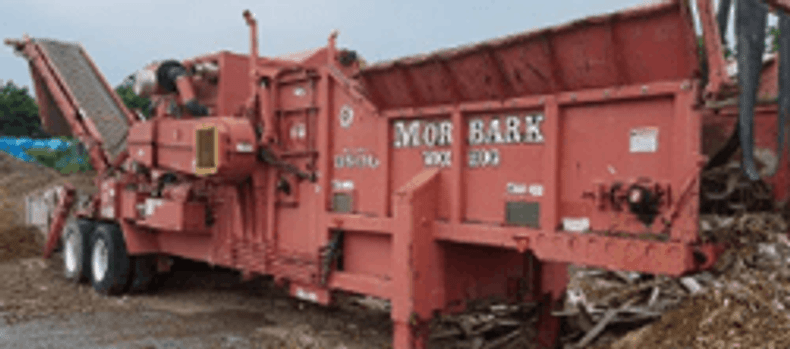Horizontal Grinders were first introduced in the late 90’s as an alternative to the tub grinder. Similar to tub grinders, there are a variety of sizes and horsepower, designed to handle land-clearing debris, bark, brush, logs, stumps, wood construction and demolition (“C&D”) material, leaves, etc. Operators typically employ horizontal grinders to reduce or recycle wood and green waste.
Many operators produce salable product such as mulch, colored mulch, boiler fuel and compost. Other operators use their grinder to reduce the volume of green waste material to minimize trucking costs and save on fuel and dump or tipping fees. In contrast with the tub grinders, horizontal grinders use a positive-feed design to feed material into the hammermill. The most common type of horizontal grinders utilize a long, narrow infeed with a belt, chain or slats and an infeed roller that feed material horizontally into the mill; thus the name “horizontal grinder”.
Common brands include: Bandit, CBI, Diamond-Z, Doppstadt, Duratech, Fecon, Morbark, Peterson, Precision Husky, Rotochopper, and Vermeer.
Production rates and capability of the horizontal grinders vary primarily with the weight, horsepower and size of the horizontal grinder. Smaller grinders may produce 20 yards of finished product an hour while larger grinders are capable of processing several hundred yards of finished product an hour.
Most horizontal grinders are powered by diesel engines, although many manufacturers also offer electric options. Caterpillar is the most common brand of engine in larger machines, although Cummins and John Deere are used frequently as well. Horsepower ranges from the mid 200’s to as high as 1200 in the largest machines.
Horizontal grinders employ a cylindrical shaped hammermill at the heart of the machine similar to tub grinders. Below and behind the hammermill are ½” to 6” screens which permit the material to pass through once the desired product size is achieved. A conveyor belt or augers located below the screens transports the finished product away from the mill to the discharge conveyor which carries the material away from the machine. Horizontal grinders are commonly mounted onto a rubber tire mounted frame with a fifth wheel-hitch. Although due to the greater use of horizontal grinders for land-clearing, track mounted horizontal grinders are also common. In some cases pintle hitches are offered but due to the weight associated with horizontal grinders most are fifth-wheel arrangements.
Horizontal grinders are typically loaded from the top with an excavator or grapple. Due to the relatively narrow infeed, pre-arranged material allows for maximum feeding efficiency. Due to the horizontal feed system, horizontal grinders are less likely to eject material than tub grinders. The grinding mechanism in horizontal grinders is not exposed in a way that will easily allow material to escape out of the machine. Consequently, they have become popular as an option for operating in populated areas.

